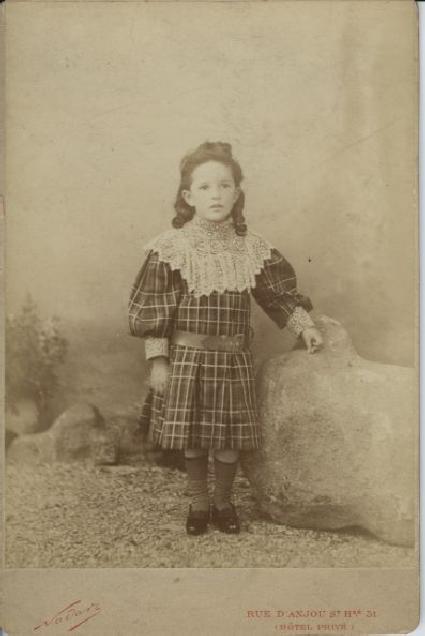
Studio Cabinet Card Lettering Colors

Figure 1.-- The French boy here was Maurice Terrillon. The cabinent card here was done with red lettering in 1894. The Nadar studio was the best known in France. The printing on the front was rather basic. Put the cursor on the image to see the back.
|
|
Several different colors were used for the print on the cards identifying the photographer and location. We notice many different colors being used.Usually the same color was used on the front and back. We do not yet know just what the color trends were and the chronological pattern if any. This was often the same color as borders, but we will consider borders separately. The color trends may have varied from country to country. That is another question we needed to address.
Black
We note gold lettering on cbinent card noints, often with with dark colored mattes. The colors included dark shades of black, blue, brown, and green. We are not yet sure about the chronology, but believe this began in the 1880s. We are not sure just when in the 1880s. We see a brown American card with gold lettrs in 1888. brown Another brown example is example is an American card in 1891. We hope to develop a more precise chronology as we find more dated examples.
Silver
We think silver lettering was most popular in the late 1890s and 1900s. They seem to have been used on light-colored cards. we see a card of an American boy, Donald W. Simpson, done with creamy colors and silver letters in 1901. We note a portrait of two unidentified German children in 1906 that is a greenish-grey card with silver lettering. We note an unidentified child in 1902 with a grey card and silver lettering..
Red
We see some cards done with red print. The French card here was done with red print in 1894 (figure 1). The Nadar studio was the best known in France. The printing on the front was rather basic.
White was another lettering color commonly used. Thuis is not a color we commonly see in early cabinent cards. We have just begun our assessment here, but believe white letters were most common in the 1890s and 1900s. We note one German card of an unidentified Halberstadt fmily that had a cream-colored mount and white letters which was made in 1892. We also notice American cabinent cards during this period.
HBC

Navigate the Boys' Historical Clothing Web Site:
[Return to:Main cabinent card mount page]
[Return to:Main photographic print type page]
[Return to:Main photography page]
[Introduction]
[Activities]
[Biographies]
[Chronology]
[Clothing styles]
[Countries]
[Bibliographies]
[Contributions]
[FAQs]
[Glossaries]
[Images]
[Links]
[Registration]
[Tools]
[Boys' Clothing Home]
Navigate the Boys' Historical Clothing Web Site:
[Sailor suits]
[Sailor hats]
[Buster Brown suits]
[Eton suits]
[Rompers]
[Tunics]
[Smocks]
[Pinafores]
Created: 12:33 AM 12/20/2006
Last updated: 5:47 AM 4/4/2009



